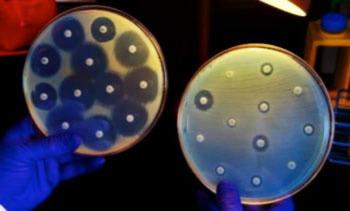Common Bacteria May Become Antibiotic-Resistant Superbugs
By LabMedica International staff writers
Posted on 08 Apr 2015
Pathogenic Enterobacteriaceae, including Escherichia coli and Klebsiella pneumoniae, are major causes of multidrug resistant (MDR) infections in hospitals worldwide and these pathogens have recently been shown to have acquired resistance to carbapenems. Posted on 08 Apr 2015
Two genes have been identified that confer resistance against a particularly strong class of antibiotics can be shared easily among a family of bacteria responsible for a significant portion of hospital-associated respiratory and urinary infections.

Image: The plate on the right was inoculated with a Carbapenem-Resistant Enterobacteriaceae (CRE) bacterium that proved to be resistant to all of the antibiotics tested; bacteria in the left plate are susceptible to the antibiotics on the discs (Photo courtesy of James Gathany).
Scientists at Washington University School of Medicine (St. Louis, MO, USA) collected 450 bacterial isolates, including 195 Enterobacteriaceae in Pakistan, during February 2012 to March 2013. They randomly selected 55 Enterobacteriaceae isolates for whole-genome sequencing. They then selected 23 isolates from samples collected in the USA during January 2010 to June 2013 from patients in Barnes Jewish Hospital (St. Louis, MO, USA), that had similar proportions of β-lactam susceptibility and resistance to the isolates collected in Pakistan for sequencing.
The investigators also sequenced a special portion of bacterial genetic material called plasmids. Most of a bacteria's DNA is found in its chromosome, but bacteria also have many extra, smaller and circular bits of DNA known as plasmids that easily can pass from one bacterial strain to another. A plasmid is like a bacterial gene delivery truck; it is the primary way antibiotic resistance genes spread between bacteria.
The variety of strains that they discovered encoding Klebsiella pneumoniae carbapenemase (KPC) and New Delhi metallo-β-Lacatamase-1 (NDM-1) was consistent with existing evidence that horizontal gene transfer (HGT) is a major factor in their spread. They identified a few key instances in which the plasmids carrying NDM-1 or KPC were nearly identical, which means they easily could facilitate the spread of antibiotic resistance between disease-causing bacteria found in the USA and South Asia.
Gautam Dantas, PhD, associate professor of pathology and immunology, a senior author of the study, said, “Our findings also suggest it's going to get easier for strains of these bacteria that are not yet resistant to pick up a gene that lets them survive carbapenem treatment. Carbapenems are one of our last resorts for treating bacterial infections, what we use when nothing else works. As drug-resistant forms of Enterobacteriaceae become more widespread, the odds will increase that we'll pass one of these superbugs on to a friend with a weakened immune system who can really be hurt by them.” The study was published online in March 2015 for the June 2015 issue of the journal Emerging Infectious Diseases.
Related Links:
Washington University School of Medicine
Barnes Jewish Hospital













